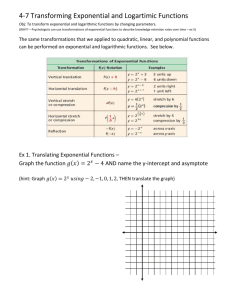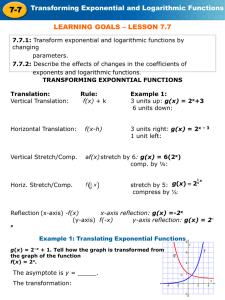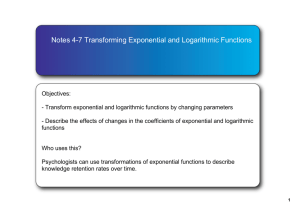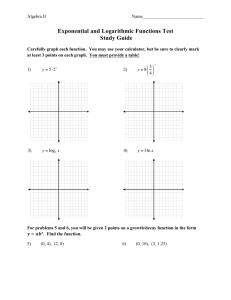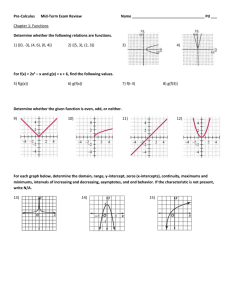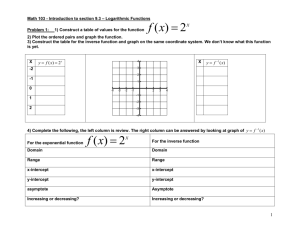Transforming Exponential and Logarithmic Functions
advertisement
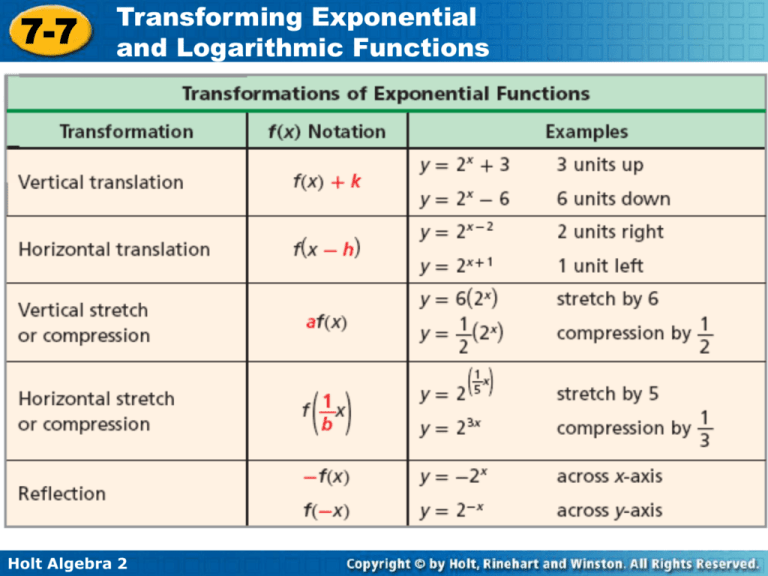
7-7 Transforming Exponential and Logarithmic Functions Holt Algebra 2 7-7 Transforming Exponential and Logarithmic Functions What is the exponential parent function? Any base raised to a power is a parent function. For example, f(x) = 5𝑥 is the parent function for 𝑔 𝑥 = −5𝑥+1 , and f(x) = 𝑒 𝑥 is the parent function for 1 𝑥 2 g(x) = 3𝑒 . All exponential parent functions have the properties: • Horizontal asymptote: y = 0 • y-intercept: (0, 1) • Domain: (-∞, ∞) • Range: (0, ∞) Holt Algebra 2 7-7 Transforming Exponential and Logarithmic Functions Example 1: Translating Exponential Functions Given: g(x) = 2–x + 1. Tell how the graph is transformed from f(x) = 2x. What is the asymptote? y-intercept? Domain and range? Reflect over y-axis. Vertical shift up 1. Asymptote: y = 1. y-intercept: (0, 1). Domain: (-∞, ∞). Range: (1, ∞). Holt Algebra 2 7-7 Transforming Exponential and Logarithmic Functions Check It Out! Example 1 Given: g(x) = 2x – 2. Tell how the graph is transformed from f(x) = 2x. What is the asymptote? y-intercept? Domain and range? Horizontal shift right 2. Asymptote: y = 0. y-intercept: 20-2 = 2-2 = ¼: (0, ¼) Domain: (-∞, ∞). Range: (0, ∞). Holt Algebra 2 7-7 Transforming Exponential and Logarithmic Functions Check It Out! Example 1 𝟐 Given: g(x) = (𝟏. 𝟓)𝒙 . Tell how the graph is 𝟑 transformed from its parent function. What is the asymptote? y-intercept? Domain and range? Parent function: (1.5)x Vertical compression by 2/3. Asymptote: y = 0. y-intercept: (0, 2/3) Domain: (-∞, ∞). Range: (0, ∞). Holt Algebra 2 7-7 Transforming Exponential and Logarithmic Functions Example 4A: Writing Transformed Functions Write each transformed function. f(x) = 4x is reflected across both axes and moved 2 units down. f(x) = 4x Begin with the parent function. g(x) = 4–x To reflect across the y-axis, replace x with –x. g(x) = –4–x To reflect across the x-axis, multiply the function by –1. = –(4–x) – 2 To translate 2 units down, subtract 2 from the function. Holt Algebra 2 7-7 Transforming Exponential and Logarithmic Functions Example 4A: Writing Transformed Functions Write each transformed function. f(x) = ex is shifted up 1 unit, horizontally compressed by a factor of ½, and vertically stretched by a factor of 3. f(x) = ex Begin with the parent function. g(x) = e2x Horizontal compression: 1 = 2. 1 2 g(x) = 3e2x Vertical stretch: place a 3 in front of the base. g(x) = 3e2x + 1 To translate 1 unit up, add 1 to the function. Holt Algebra 2 7-7 Transforming Exponential and Logarithmic Functions Homework Online Assignment Holt Algebra 2
